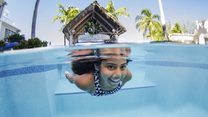On This Page
In Cayman's tropical climate, where the sun is strong and a good deal of time is spent outdoors, sun safety is a priority.
Protecting Skin from the Sun
Whilst skin melanoma is rare in children, protecting their skin from a young age is essential for lifelong health. It is especially vital because, at this age, children often spend a lot of time playing outdoors. Receiving multiple sunburns while you're young can significantly impact the skin as it ages, and it's often hard to see the damage until it's too late. When it comes to teaching your kids about solar protection, the earlier, the better! If you have any concerns about your child's skin, contact one of the clinics listed below, they all offer dermatology services.
Top Tip
Kids spend a lot of time in school playgrounds so don’t forget to apply sun screen to them before school and encourage them to wear their hats during lunchtime.
Here are some dos and don'ts of skin sun safety.
DO:
- Apply SPF30 or higher sunscreen every morning before school and keep a bottle of sunscreen in their school bag.
- Use a reef-friendly sunscreen when spending time on the beach.
- Reapply sunscreen every two hours, before an outdoor activity and after swimming or towelling off, even if the sunscreen is ‘water resistant’.
- Throw away any sunscreen that you’ve had open for longer than 12 months or that has ‘split’ or changed in texture.
- Keep infants under six months out of the sun as much as possible and keep children out of the sun during the hottest parts of the day when possible (10am to 4pm).
- Cover up using a sun top, sunglasses and a hat. Choose clothes where you can’t see your hand through the fabric.
- Be generous in the amount of sunscreen you use.
- Apply in advance – it takes approximately 15 minutes for sunscreen to sink into your skin.
DON’T:
- Buy spray-on sunscreens as they may harm children’s lungs.
- Leave sunscreen in the sun.
- Use a sunscreen that includes bug repellents – the sunscreen’s ability to screen out UV can be decreased by the repellent, whilst the toxicity of the repellent is increased.
- Miss less obvious areas like ears, feet, mouth, neck and back of the knees.
Protecting Eyes from the Sun
Infants and children lack the pigment in their eyes that help filter UV light, so making your kids wear sunglasses is crucial. The reflective surfaces of sand and water can almost double your UV exposure. Here are six things to bear in mind when buying sunglasses for kids:
- Glasses should offer 99-100% UV protection.
- Select more durable polycarbonate lenses.
- Wrap-around glasses offer the best protection.
- Grey-coloured lenses are best as they absorb all colours equally so kids can see the world in natural colours.
Knowing what to look for is only half the battle. It can sometimes feel impossible to encourage stubborn little ones to wear sunglasses. Here are a few tips which might help:
- Let kids choose between colours or styles if possible.
- Set a good example by putting them on whenever you leave the house.
- Draw their attention to older kids, athletes and celebrities who are wearing shades.
- If you can’t get them to keep sunglasses on, make sure they wear wide-brimmed hats for all activities in the sun.







